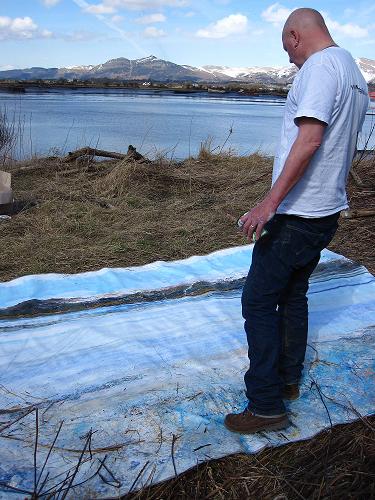Friend of the river, Kurt Jackson, has a new exhibition at Dovecote studios in Edinburgh which runs from 11 – 28 May. Here’s the press release:
“The Gaelic translation of River Forth is Abhainn Dhubh, which means ‘black river’. Stretching for some thirty miles, the Forth is the uncelebrated pantomime villain of the major British rivers.” Irvine Welsh.
Kurt Jackson is one of Britain’s most celebrated landscape artists whose latest project has taken him north of the border to the scene of a memorable visit he first made almost 34 years ago. Based in Cornwall, Kurt Jackson is a dedicated and informed environmental campaigner whose work both celebrates the natural world around him as well as highlighting the dangers it now faces.
Following the enormous success of his one man show at Dovecot Studios last year, Kurt Jackson was invited to exhibit again with a show that charts the progress of one of the country’s major rivers from its source to the sea.
Rising in the mountains of the Trossachs, the Forth flows east through Stirling before widening into an estuary on reaching Kincardine and becoming the Firth of Forth. The return to the river was laced with nostalgia for Jackson who first visited the area as an impressed and impressionable teenager. Years later he has re-traced his steps, documenting his journey through the eyes of an artist with a deep understanding of natural history and ecology, politics and environmental issues.
Kurt Jackson explained: “When I was sixteen (I’m now nearly fifty), and under the spell of Kerouac, I decided to take a trip. I had no money and didn’t know where I was going. I walked to the nearest motorway in southern England, put out my thumb, and after many lifts and hours of travelling north, found myself crossing the Firth of Forth, driven by an old hippy. He took me to a commune on the banks of the Forth where I spent a few days mixing with a bunch of happy (and mostly naked) people. For a sixteen-year-old it was all a bit wild and memorable, but also, and maybe especially the crossing and my first encounter with that big river, was something I never forgot. I have always wanted to return and follow the river to see where she came from – this is that journey, and this is the body of work – paintings, etchings, sculpture and a film.”
Kurt Jackson –“The Forth” is a remarkable insight into the dynamic and spontaneous processes of Jackson’s project, the works are fluent, dynamic, intimate and immediate, resulting from a working method that is challenging and intense. The exhibition will be the artist’s sixth in Scotland and opens at the famous Dovecot Studio Gallery in Edinburgh where his previous shows have proved so successful.
Fitting for a gallery famed for its weaving, the exhibition will also feature a pure wool rug, made for the occasion by weaver Jonathan Cleaver, and depicting Kurt Jackson’s painting of the Grangemouth power station at night. Jonathan Cleaver took four weeks to make the piece using a compressed air technique known as gun-tufting to shoot the wool pile through the backing cloth. He explained: “Rug tufting gives a surface with incredibly rich and deep colour, so the intense midnight-blues of Kurt Jackson’s image of Grangemouth made it well suited to be translated into a rug.”
Kurt was introduced to the tufting process during his 2010 exhibition at Dovecot Studios, but the idea of working on a rug together had originated earlier, when Dovecot director David Weir visited the artist’s studio and saw the fluidity with which Jackson worked across media.
The Grangemouth design was selected by Head Weaver Douglas Grierson as having expressive marks in sympathy with the scale and style of the tufting technique, but it is considered that Jackson’s work could be a source for many more stunning rugs.
The exhibition at Dovecot Studios has been put together by Louise Jones of the prestigious Lemon Street Gallery in Truro, Cornwall, who says Jackson’s background as an environmentalist gives him a different perspective to many of his contemporaries.
She said: “Kurt’s way of looking at the Scottish landscape is not a traditional one. A lot of artists tend to take their inspiration from the Glasgow movement whereas Kurt goes straight back to the environment for his inspiration every time. Capturing a fleeting impression does not interest him at all. His work is all about conveying his own feelings and responses to environment at whatever the given point in time.”
